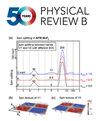Bi2 ^ Te3纳米薄膜中的非线性声子:一个理论方法
IF 3.7
2区 物理与天体物理
Q1 Physics and Astronomy
引用次数: 0
摘要
密度泛函理论计算不仅可以预测固体的振动和光学性质,而且可以理解和解开在相干光学声子产生中起关键作用的机制。最近在Bi2¹Te3纳米级薄膜上进行的实验表明,太赫兹(THz)脉冲发射至少一个相干𝐴11¹𝑔声子,因为使用各向同性检测方案测量的瞬态透射率显示的振荡频率与拉曼实验中测量的𝐴11¹𝑔模式的频率相匹配。这样的观察结果可以通过调用和频率过程或立方或四次声子-声子耦合来解释,如Bi2¹Se3的母体化合物Bi2¹Te3所考虑的那样。利用群论和第一性原理计算能量面,可以识别主要的声子-声子耦合。此外,还可以建立最小模型来计算在实验太赫兹脉冲驱动下拉曼主动模式与红外主动模式耦合的动力学。我们的模型牢固地建立了立方声子-声子相互作用是相关的,因为计算和实验透射率之间的一致性是值得注意的。本文章由计算机程序翻译,如有差异,请以英文原文为准。
Nonlinear phononics in Bi2Te3 nanoscale thin films: A theoretical approach
Density functional theory calculations not only allow to predict the vibrational and optical properties of solids but also to understand and disentangle the mechanisms playing a key role in the generation of coherent optical phonons. Recent experiments performed on a Bi2Te3 nanoscale thin film have shown that a terahertz (THz) pulse launches at least a coherent 𝐴1
1𝑔 phonon as the transient transmittance measured using an isotropic detection scheme displays oscillations with a frequency matching the frequency of the 𝐴1
1𝑔 mode measured in Raman experiments. Such an observation can be explained by invoking either a sum-frequency process or cubic or quartic phonon-phonon couplings as considered for Bi2Se3, a parent compound of Bi2Te3. By resorting to group theory and calculating energy surfaces from first principles, the main phonon-phonon couplings can be identified. Furthermore, a minimal model can be built to compute the dynamics of the Raman active modes coupled to the infrared active mode driven by the experimental THz pulse. Our model firmly establishes that cubic phonon-phonon interactions are relevant as the agreement between the computed and experimental transmittance is noteworthy.
求助全文
通过发布文献求助,成功后即可免费获取论文全文。
去求助
来源期刊

Physical Review B
物理-物理:凝聚态物理
CiteScore
6.70
自引率
32.40%
发文量
0
审稿时长
3.0 months
期刊介绍:
Physical Review B (PRB) is the world’s largest dedicated physics journal, publishing approximately 100 new, high-quality papers each week. The most highly cited journal in condensed matter physics, PRB provides outstanding depth and breadth of coverage, combined with unrivaled context and background for ongoing research by scientists worldwide.
PRB covers the full range of condensed matter, materials physics, and related subfields, including:
-Structure and phase transitions
-Ferroelectrics and multiferroics
-Disordered systems and alloys
-Magnetism
-Superconductivity
-Electronic structure, photonics, and metamaterials
-Semiconductors and mesoscopic systems
-Surfaces, nanoscience, and two-dimensional materials
-Topological states of matter
 求助内容:
求助内容: 应助结果提醒方式:
应助结果提醒方式:


